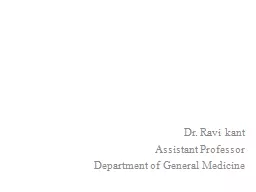

Dr Ravi kant Assistant Professor Department of General Medicine Introduction Cirrhosis is a condition that is defined histopathologically and has a variety of clinical manifestations and complications some of which can be lifethreatening ID: 762971
Download Presentation The PPT/PDF document "Dr. Ravi kant Assistant Professor Dep..." is the property of its rightful owner. Permission is granted to download and print the materials on this web site for personal, non-commercial use only, and to display it on your personal computer provided you do not modify the materials and that you retain all copyright notices contained in the materials. By downloading content from our website, you accept the terms of this agreement.
Dr. Ravi kant Assistant Professor Department of General Medicine
Introduction Cirrhosis is a condition that is defined histopathologically and has a variety of clinical manifestations and complications, some of which can be life-threatening. In the past, it has been thought that cirrhosis was never reversible; however, it has become apparent that when the underlying insult that has caused the cirrhosis has been removed, there can be reversal of fibrosis. This is most apparent with the successful treatment of chronic hepatitis C; however, reversal of fibrosis is also seen in patients with hemochromatosis who have been successfully treated and in patients with alcoholic liver disease who have discontinued alcohol use.
Causes of Cirrhosis Alcoholism Cardiac cirrhosis Hepatitis B Hepatitis C Autoimmune hepatitisNonalcoholic steatohepatitisBiliary cirrhosis Primary biliary cirrhosis Primary sclerosing cholangitis Autoimmune cholangiopathy Chronic viral hepatitis Inherited metabolic liver disease Hemochromatosis Wilson's disease 1 Antitrypsin deficiency Cystic fibrosis Cryptogenic cirrhosis
Alcoholic Cirrhosis Excessive chronic alcohol use can cause several different types of chronic liver disease, including alcoholic fatty liver, alcoholic hepatitis, and alcoholic cirrhosis. Furthermore, use of excessive alcohol can contribute to liver damage in patients with other liver diseases, such as hepatitis C, hemochromatosis , and those patients who have fatty liver disease related to obesity. Chronic alcohol use can produce fibrosis in the absence of accompanying inflammation and/or necrosis. Fibrosis can be centrilobular, pericellular, or periportal . When fibrosis reaches a certain degree, there is disruption of the normal liver architecture and replacement of liver cells by regenerative nodules. In alcoholic cirrhosis, the nodules are usually <3 mm in diameter; this form of cirrhosis is referred to as micronodular . With cessation of alcohol use, larger nodules may form, resulting in a mixed micronodular and macronodular cirrhosis.
Pathogenesis Alcohol is the most commonly used drug in the United States, and more than two-thirds of adults drink alcohol each year. Thirty percent have had a binge within the past month, and over 7% of adults regularly consume more than two drinks per day. Unfortunately, more than 14 million adults in the United States meet the diagnostic criteria for alcohol abuse or dependence. In the United States, chronic liver disease is the tenth most common cause of death in adults, and alcoholic cirrhosis accounts for approximately 40% of deaths due to cirrhosis.
Clinical Features The diagnosis of alcoholic liver disease requires an accurate history regarding both amount and duration of alcohol consumption. Patients with alcoholic liver disease can present with nonspecific symptoms such as vague right upper quadrant pain, fever, nausea and vomiting, diarrhea, anorexia, and malaise. Alternatively, they may present with more specific complications of chronic liver disease, including ascites , edema, or upper gastrointestinal (GI) hemorrhage. Many cases present incidentally at the time of autopsy or elective surgery. Other clinical manifestations include the development of jaundice or encephalopathy.
Diagnosis The diagnosis, however, requires accurate knowledge that the patient is continuing to use and abuse alcohol. Liver biopsy can be helpful to confirm a diagnosis, but generally when patients present with alcoholic hepatitis and are still drinking, liver biopsy is withheld until abstinence has been maintained for at least 6 months to determine residual, nonreversible disease.
Treatment Complications such as the development of ascites and edema, variceal hemorrhage, or portosystemic encephalopathy all require specific management and treatment. Glucocorticoids are occasionally used in patients with severe alcoholic hepatitis in the absence of infection. Survival has been shown to improve in certain studies. Treatment is restricted to patients with a discriminant function (DF) value of >32. The DF is calculated as the serum total bilirubin plus the difference in the patient's prothrombin time compared to control (in seconds) multiplied by 4.6.
In patients for whom this value is >32, there is improved survival at 28 days with the use of glucocorticoids . Other therapies that have been used include oral pentoxifylline , which decreases the production of tumor necrosis factor (TNF-) and other proinflammatory cytokines. In contrast to glucocorticoids, with which complications can occur, pentoxifylline is relatively easy to administer and has few if any side effects. A variety of nutritional therapies have been tried with either parenteral or enteral feedings.